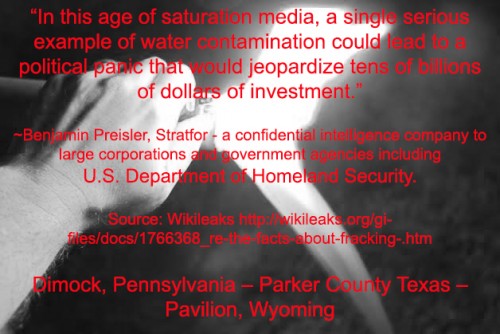Lipsky
This page, where I will attempt to lay out the story and provide documentation of contaminated water in Parker County, is a work in progress.
I’ll start with three Brett Shipp reports and add links to pertinent documentation.
NEWS 8 INVESTIGATES News video at link
by BRETT SHIPP
WFAA
Posted on July 11, 2013 at 10:00 PM
Updated Friday, Jul 12 at 2:00 PMAn old debate is being rekindled over whether gas drilling in the Barnett Shale is to blame for flames shooting out of water wells in Parker County.
News 8 has obtained records showing a drilling operation was in violation of state law at the same time area land owners say their water wells were suddenly contaminated with natural gas.
(TX Administrative Rule 13)
(EPA endangerment order against Range)
(Dawson water test)
(Lipsky water test)
(Perdue water test)
(Struhs water test)
(Struhs water test 2)Parker County resident Steve Lipsky first ignited a debate over whether gas well drilling company Range Resources was responsible for his water well filled with enough natural gas to vent flames.
Now his neighbor, Shelly Perdue, is telling a similar story.
“I could heat my home with this,” Perdue said as she showed News 8 how she can light her well water on fire.
But Perdue doesn’t want to heat her home. She just wants to know why in 2009 her well water bubbled up and went bad just weeks after Range Resources drilled a gas well just a few hundred feet from her home.
Lipsky, who lives a half mile away, says his water well went bad in December 2009. He complained to the state alleging that a newly drilled gas well was to blame.
The Texas Railroad Commission investigated and discovered a problem. Gas pressure was forming on the wellhead, indicating gas was escaping down well.
The state issued Range Resources a notice of violation.
So where could that escaped gas be coming from? In order to prevent fracked gas from migrating out of the Barnett Shale, Range Resources circulated a protective layer of cement on the outside of the production pipe from the bottom up to about 4,500 feet. They also cemented from the top of the well, down through the aquifer where Perdue and Lipsky and others get their water, to about 400 feet. That left a long stretch of open well from about 400 feet to 4,500 feet uncemented and unprotected.
Of particular concern is a shallow gas formation just beneath the aquifer called the Strawn, which was left uncemented. Is this the gas migrating up the wellhead, or worse, into the aquifer?
According to the Railroad Commission’s rule 3.7, whenever gas is encountered while drilling, it “shall be confined in its original stratum” to keep it from moving up the well and contaminating an aquifer.
Another rule, 3.13, says “if any productive horizon is open to the wellbore … the casing shall be cemented,” again, to keep any gas from infiltrating the water supply.
That’s called zonal isolation, said Tony Ingraffea, Cornell University engineering professor.
“This is why, by regulation, zonal isolation has to be maintained and if it is not maintained initially the well has to be worked over to achieve zonal isolation and if the well cannot be repaired to achieve zonal isolation, then the well has to be abandoned, taken out of production and plugged,” he said.
Another expert, Texas A&M engineering professor Jerome Schubert, agrees that all gas zones down well must be protected.
“It should be done by the operator,” he said. “It’s just good operating practices”.
In a review of Railroad Commission records, News 8 discovered correspondence between Range Resources and state regulators in which the driller agreed it had a problem. In response to that 2010 violation, Range proposed to fix its wellhead pressure problem by “circulating the cement to the surface.” (Disk file 4)
Range added, “this work is to eliminate any chance that gas could be migrating from any zone” down below.
“It tells me that they waited over a year to actually realize they should have cemented to surface and realize that apparently they knew they had a problem,” Lipsky said.
But Range Resources never added the cement down well. No repairs were ever made, and the violation for gas pressure on the wellhead was later dropped by the Railroad Commission, which went on to rule that Range was not responsible for the flames coming out of the Lipsky water well.
The state also says the well is in full compliance with the law.
Range Resources declined our interview request but issued this statement:
“Natural gas, predominantly methane, is naturally present in the Trinity Aquifer in the area. Numerous state agencies, landowners and businesses have records of naturally occurring methane in the water prior to Range’s activity.”
Range produced volumes pages of documents supporting its position, including pictures of signs at a nearby water supply warning of gas in the water table. As for that wellhead pressure, Range says it’s not uncommon and “does not, by itself, indicate that the mechanical integrity of a well is compromised.”
As for those state rules that require hydrocarbon or gas formations be protected by cement, Range says that only applies to “commercially productive” formations, not the Strawn.
And who decides what is “commercially productive”? According to the Texas Railroad Commission, the drilling company decides.
Ingraffea says that amounts to no regulation at all.
“If that were the case, then… every well that has ever been drilled through any hydrocarbon bearing formations that are not a target of production would not have to be zonally isolated. That’s absurd.”
While experts debate well mechanics, some landowners remain in the dark over why their wells are still polluted and whether man or Mother Nature is to blame.


